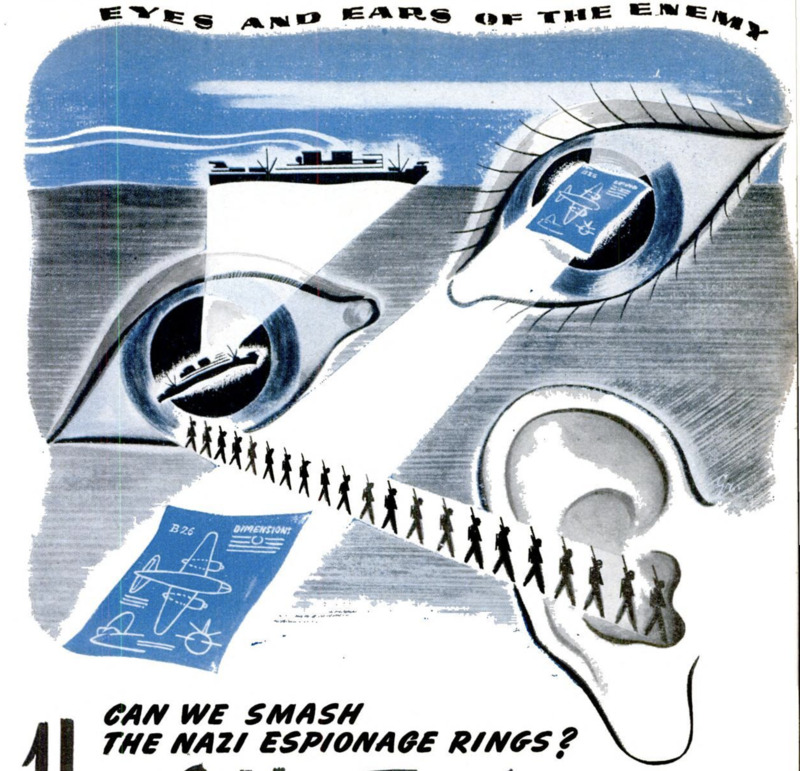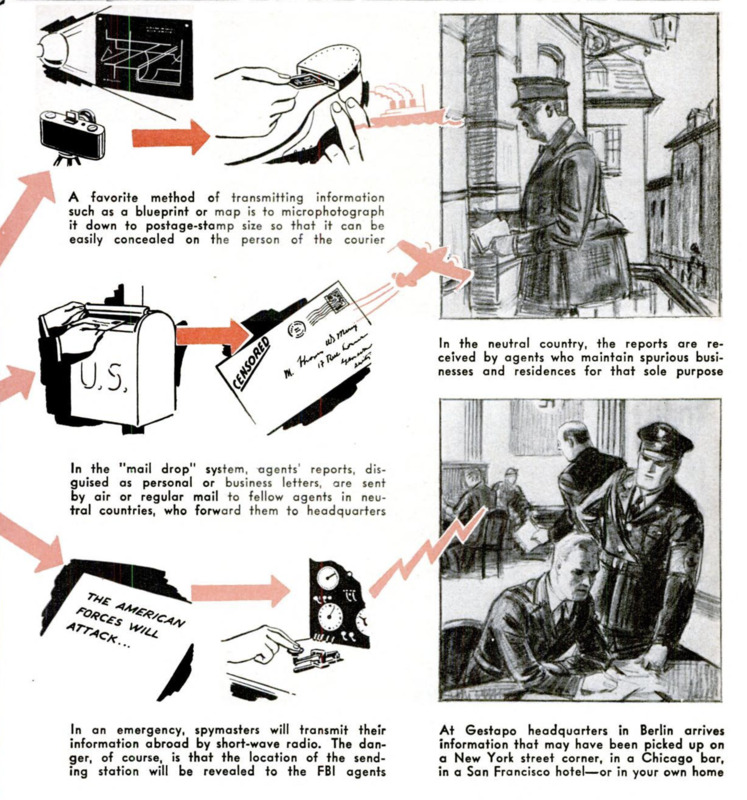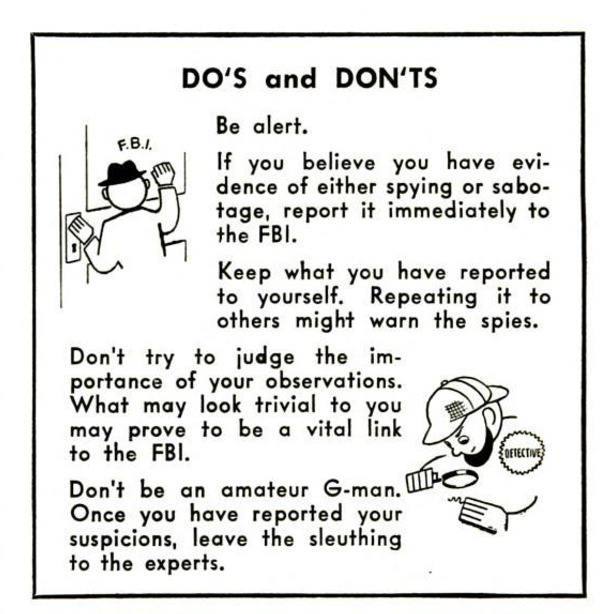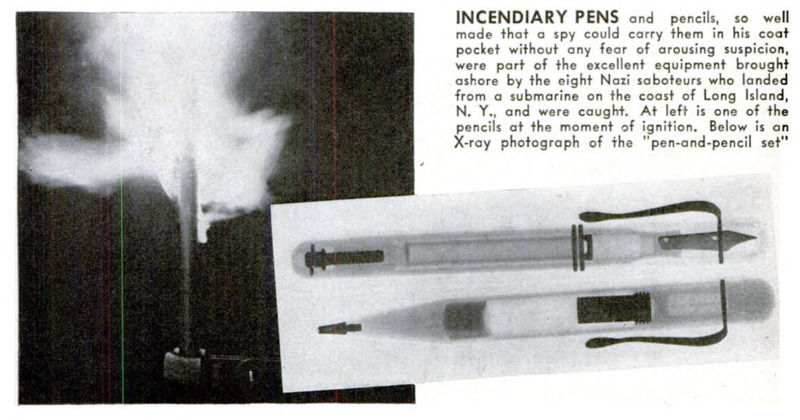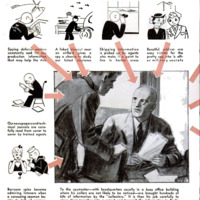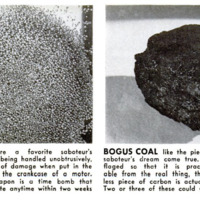-
Title (Dublin Core)
-
Can We Smash the Nazi Espionage Rings? How G-Men trap Axis Spies
-
Article Title and/or Image Caption (Dublin Core)
-
Can We Smash the Nazi Espionage Rings? How G-Men trap Axis Spies. Using Every Means of Scientific Detection, the FBI Is Outwitting Gestapo's Best Secret Agents.
-
extracted text (Extract Text)
-
IN A little waterfront tavern at Port Rich-
mond, N. Y., few patrons even noticed the
stoop-shouldered, 57-year-old porter, busy
with mop and pail. Anyone taking the
trouble to inquire would have learned that
he operated his pleasant brick home in
near-by Tompkinsville as a boarding house
for service men, and that he was one of the
most zealous air-raid wardens to be found
in the vicinity.
Yet, at this writing, he faces a long
prison term or the electric chair, as a self-
confessed Nazi spy. And a United States
Attorney declares, “This is one of the most
important arrests made in an espionage
case in this country since the declaration
of war. The FBI is entitled to full credit
for its surveillance and eventual capture of
this man.”
His house, Federal Bureau of Investiga-
tion agents pointed out, topped the highest
point on all of Staten Island. From his attic
windows he had a perfect view of Allied
ships bound out of New York Harbor, and
could relay information of the highest value
to U-boats ready to intercept them. What
he did not see for himself, he could pick up
from careless conversation at the tavern
where he worked—and at others that he
made it his business to visit in off hours.
His roomers, too, may have unwittingly
furnished him with information of great
importance to the Nazis.
Through underground channels, G-men
say, he was able to enlist the aid of a
most helpful accomplice. Well trained in
engineering, this man was employed in an
Eastern airplane factory. The engineer
could supply just what the Nazis particu-
larly wanted—production figures for Ameri-
can planes, and diagrams of the latest mod-
els. Among other things, he turned over to
his_fellow-conspirator a complete set of
highly confidential plans for a new bomber.
Delighted with what he could now forward
t0 his superiors in Germany, the Tompkins-
ville spy pressed $100 into the engineer's
none-too-reluctant hands. It was a hand-
some sum among Hitler's underpaid spies,
even for the risk taken by the engineer. (He
was to find out about that later, when FBI
men caught up with him; he, too, has been
arrested and has confessed.)
More industrious than imaginative, the
Tompkinsville agent followed a familiar
method—the “mail drop” system—to get
his information to the Fatherland. He typed
innocent-looking letters to “friends” in neu-
tral foreign countries. Victory gardens,
‘Washington's Birthday, and California wine
came in for mention, and there were expres-
sions of pleasure at American victories over
the Japanese. But the letters also bore, in
invisible ink, information on arms ship-
ments, troop movements, convoy sailing
dates, and industrial production figures. To
make the ink, the writer dissolved in water
a white powder, which he had been told to
call an eye wash if questioned. Traveling
by Clipper mail planes, the letters were in-
tended to reach foreign Nazi sympathizers
who would speed them to their destination.
‘The invisible ink, of a kind well known to
expert searchers for hidden messages, was
the one weak spot in an otherwise flawless
sctup. When the authorities examined the
Clipper mail, they quickly detected it. In-
stead of going abroad, the letters went to
the FBI, which took over the months-long.
task of tracing them back to the sender.
Of course, he had not been obliging
cnough to give a return address. The Tomp-
kinsville postmark was the only clue. Ques-
tioning postmen, the G-men patiently ran
down one false lead after another, until
their search narrowed to the street where
the suspect lived. When they finally nabbed
him, his nearest neighbors were amazed to
learn of his clandestine activities.
In the first World War our organization
for combatting spies and saboteurs— of
which this writer was a member—was a
hastily improvised hodgepodge of several
Government agencies and an amateur outfit
whose well-meaning members had a discon-
certing habit of getting under the profes-
sionals’ feet at crucial moments. President
Roosevelt averted a repetition of that mis-
take when, in 1039, he designated the
Federal Bureau of Investigation and our
military and naval intelligence services to
handle all espionage and sabotage matters,
with the FBI as the co-ordinating agency.
Since then, the G-men have investigated
thousands of cases involving reported es-
plonage and sabotage. These range from
honestly mistaken “scares” to life-and-death
battles of wits with master spy rings.
No less than 174 “parachute landings” in
this country were reported by anxious citi- |
zens between June, 1942, and last March,
according to J. Edgar Hoover, director of |
the FBI Every report was investigated and |
proved unfounded. What the observer usual-
ly saw was a bird or kite.
Similarly, at a time when “U-boats” were
being sighted along the coasts in fantastic |
numbers, a high Navy official remarked,
“They'll be sceing flying submarines next.”
He was right. A woman air-raid warden in
an eastern coastal area agitatedly reported
that a submarine was flying overhead. She |
had never before seen a U.S. Navy blimp. |
Of the many fanatics and crackpots who |
have fancied themselves as “lone wolf” Nazi
saboteurs, perhaps the boldest was a Ger- |
man who attempted to sell the formula of
an antifreeze compound for airplane motors
to the United States Government. FBI
agents spoiled the deal when they overheard
the German's private comment that a few
drops of picric acid, added to the compound
by a saboteur, would wreck each engine.
But these are small fry, compared with
organized spy rings that the FBI has
smashed. Headed by top-notch espionage
men trained in a special German school,
they work something like this: |
In charge is a director—the spymaster.
Usially he has his headquarters im a reper
table and busy office building in which call-
ers are not likely to be especially noticed,
and conducts his affairs behind doors let.
tered with the name of a real or—more
often—phony business concern. Reporting
to him are a varying number of “collectors”
who do the routine spying. All of them are
inconspicuous people and most of them hold
down inconspicuous jobs. They are wait-
resses in military-area. lunchroom who re.
port that last night Private Smith was
Erouching because wearing the tin hat Just
fasued to him gave him a headache; factory
workers who tell the director how they
overheard the super telling the foreman
that the front office had got an order for
20,000 more of those machine-gun mounts:
shabby men who ait all day in hail bed-
Toms, fine-combing newspapers and tech.
Bical Magazines for pertinent news ftems.
Pieced together by a highly trained spy.
master, dozens and even hundreds of these
bits and pieces of information make up
most model-1043 espionage reports.
“Transmission by short-wave radio is of
course the quickest means of overseas com.-
munication, and It is used by spies for send.
ing news of ship sailings and large-scale
troop movements—i/ (and in these war
days it is a mighty big if) they dare use
their transmitters. When speed in delivery
is not essential, espionage reports usually
are sent by air or regular mail, addressed
to'a “mail drop” In some neutral country
sy, a spurious business ofice maintained
for the sole purpose of receiving mail from
spies operating in enemy or untriendly coun.
tries and forwarding it to Germany or
Japan. As in wartime all foreign-addressed
mail ls subject to censorship, espionage
communications sent by post Tust be cam:
ouflaged to avert suspicion. Usually the
camouflage is a natural-sounding business
letter typed on one side of the sheet. This
may be a coded message, or may serve as a
blind for another in invisible ink.
Blueprints, maps, sneaked tracings of de-
signs and plans, and important documents
which must be sent abroad in unabridged
form usually are microphotographed, in the
manner of a V-mail letter, by an expert as-
signed to the ring. The microfilm, little
larger than a postage stamp, is carried con-
cealed on the person of a courier.
Illicit radio transmitting stations are lo-
cated so quickly and accurately by the many
scores of Federal Communications Commis-
sion listening posts scattered all over the
country that spies seldom risk using them
unless they can be moved in a hurry.
-
Contributor (Dublin Core)
-
Arthur Grahame (writer)
-
Language (Dublin Core)
-
eng
-
Date Issued (Dublin Core)
-
1943-10
-
pages (Bibliographic Ontology)
-
49-53
-
Rights (Dublin Core)
-
Public Domain (Google digitized)
-
Archived by (Dublin Core)
-
Matteo Ridolfi
-
Alberto Bordignon (Supervisor)
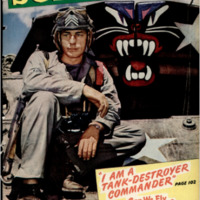 Popular Science Monthly, v. 143, n. 4, 1943
Popular Science Monthly, v. 143, n. 4, 1943

